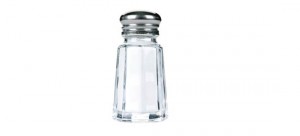
Salt is one of the oldest food seasonings known to man and salting is an important method of food preservation, but the amount of salt we shake onto our food is not usually our main source of salt intake. We get about 80 per cent of our salt as additives to the processed foods we eat.
The average Australian consumes around eight or nine times more sodium than they need. The National Health and Medical Research Centre’s (NHMRC) suggested dietary target advises that Australian adults should aim to consume no more than 4g of salt a day (or 1600mg of sodium). Generally, infants and children need less than adults.
But doesn’t the body need some salt? Yes, but the body gets sufficient salt by eating natural, unprocessed foods such as fruits and vegetables, nuts, seeds, beans and unprocessed wholegrains.
Reducing your salt intake
So how do you reduce the salt in your diet, especially if most of it is added to foods during processing?
- For a start, try simply not cooking with salt and not adding salt to your food.
- Learn to read food labels when shopping. Look at the sodium levels of foods on labels and remember the daily recommended intake.
- Some other suggestions for reducing the amount of salt in our diet include:
- Choosing reduced-salt bread and breakfast cereals – bread is a major source of sodium in the diet.
- Avoiding high-salt and high-sodium foods.
- Cutting back on processed foods, as well as takeaway and fast foods.
- Buying fresh rather than canned vegetables.
- Buying ‘low salt’ (contains less than 120mg/100g) or ‘salt free’ versions of commonly used foods, such as sauces.
- Using herbs, spices and unprocessed flavourings, such as garlic, oregano and lemon juice, to add flavour to meals.
The high-salt food list
The following foods contain a lot of salt, so eat them sparingly.
Pizza, most snack foods, potato chips, processed meats (such as sausages, salami, hot dogs and luncheon meats), canned vegetables, dehydrated or packet foods (such as instant pasta or soups and pre-packaged sauces) and condiments, (such as tomato sauce and soy sauce), as well as white bread and bread rolls.
Cutting salt from your cooking
Throw away that salt shaker. You can reduce your salt intake by 20pc just by making one simple change: not adding salt when cooking or at the table.
Avoid high-salt sauces and stocks. Most stock cubes, gravy browning, soy sauces and prepared soups are high in salt. If you can, choose low-salt (or low-sodium) alternatives or make your own stock in advance.
There are plenty of other ingredients you can add to your foods to add flavour, without adding the salt. Why not try fresh, frozen or dried herbs, onions, garlic, shallots, chillies, ginger, cinnamon, lemon juice, pepper, vinegar, red or white wine, cider or beer, or spices (but check the label to make sure that they only contain low levels of salt or sodium).
But what about the taste?
Won’t food taste too bland without salt? No. The taste for salt is acquired and is not a useful indicator of the requirement for salt. You will probably miss the salty taste at first, but once your taste buds have become acclimatised, you will discover flavours in foods that you never realised existed before. Their true tastes will emerge without the salt, which only makes their natural flavours even more delicious!
Comments are closed.